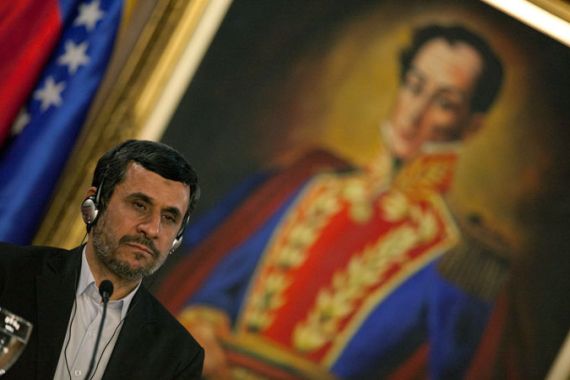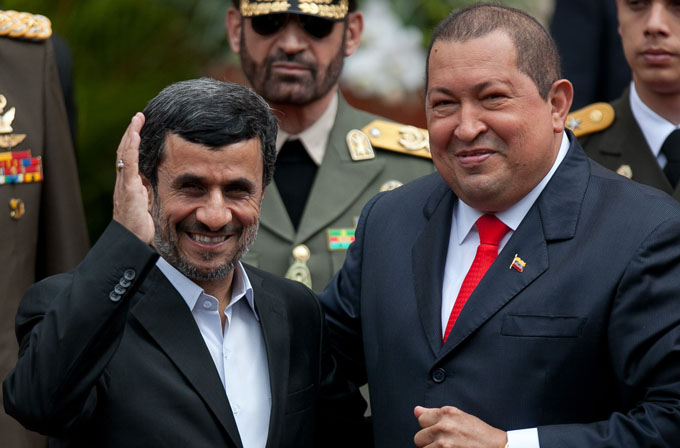Ahmadinejad contemplates Latin America caliphate
Belen Fernandez discusses Iranian President Mahmoud Ahmedinejad’s trip to Latin America and plots galore.

 |
| Chavez once facetiously remarked in reference to a corn-processing facility in Venezuela, “This is where we build the Iranian atomic bomb” [EPA] |
In September 2007, The Miami Herald columnist Andres Oppenheimer wrote:
Iran’s President Mahmoud Ahmadinejad must love the tropics. He has spent more time in Latin America than President Bush over the past 12 months.
Given that the name of the former US president was never associated with a tradition of international travel, this was not an overwhelmingly surprising calculation.
It was reiterated, however, in a 2009 investigation by Ely Karmon of the International Institute for Counter-Terrorism in Herzliya, Israel, who additionally warned that Farsi was being taught at Venezuelan universities; that a number of Iranian engineers had acquired basic Spanish; and that the Latin American poor might respond favourably to “radical Shiite ideological teachings”.
Venezuelan President Hugo Chavez’s declaration during Ahmadinejad’s visit to Caracas later that year that “I am certain that the God in Iran is the same as the God in Venezuela” presumably did not assuage concerns.
| Inside Story Americas: Is Iran finding new friends in Latin America? |
US missing in action
Oppenheimer has revised his 2007 lede in honour of Ahmadinejad’s latest excursion to the region, which kicked off on Sunday in Venezuela and has included stops in Nicaragua, Cuba, and Ecuador. In a Saturday column entitled “Ahmadinejad’s Latin America ‘tour of tyrants’“, Oppenheimer observed:
Iranian President Mahmoud Ahmadinejad will be visiting Latin America this week for the fifth time since 2007 – as often as US presidents over the same period, and visiting more countries than them. He must have powerful reasons to spend so much time in the region.
According to Jose R Cardenas, a contributor to the neoconservative American Enterprise Institute’s Venezuela-Iran project, relations between these two countries is indicative of “the growing menace of the radical Islamist regime in the Western Hemisphere”.
In a Foreign Policy blog post last month entitled “The US is MIA in Latin America“, Cardenas complained:
An end-of-the-year assessment of US policy towards Latin America could possibly qualify for the world’s shortest blog. For a President who has clearly established that foreign policy is not something that gets him up in the morning (or appears to keep him awake at night), Latin America must rank just above Antarctica in descending areas of interest.
It is not entirely clear, of course, how the US is “MIA in Latin America” when Ahmadinejad is not the one whose contemporary history includes activities such as militarising the region, inundating it with small arms, and facilitating the overthrow of the democratically elected president of Honduras. It is especially unclear how Cardenas can claim a lack of US interest beyond its southern border when he is an associate with the Washington, DC-based firm VisionAmericas – retained by the Honduran Association of Maquiladoras to lobby on Capitol Hill in support of the 2009 coup against Manuel Zelaya.
‘Tour of tyrants’
The phrase “tour of tyrants” referenced by Oppenheimer was coined by House Foreign Affairs Committee Chair Ileana Ros-Lehtinen – patron saint of Cuban exiles, sweetheart of the Zionist Organisation of America, and self-appointed bulwark against the Islamo-Bolivarian axis currently threatening life as we know it.
Discussing the purpose of Ahmadinejad’s impending reunion with the Western Hemisphere’s “anti-American despots”, Ros-Lehtinen surmised that the group would probably brainstorm “tactics for silencing free speech, suppressing the free press, and oppressing the people of these nations”.
I was blessed with the opportunity, in 2009, to witness firsthand Ros-Lehtinen’s commitment to combating oppression during her post-coup descent upon Tegucigalpa to reaffirm the righteous nature of the coup. In the same press conference in which she argued the illegitimacy of Ahmadinejad’s presidency given her contention that he had been elected by fraud, Ros-Lehtinen reasoned that, just because illegitimate coup president Roberto Micheletti had not been elected, this did not mean he had not risen to power in accordance with the law.
This was the same Micheletti, of course, who had the previous week forced two primary anti-coup news outlets off the air, and who was presiding over a regime dedicated to ongoing – and often lethal – repression of peaceful protesters.
Given Ros-Lehtinen’s assessment that the current “tour of tyrants” will result in the consolidation of “economic pacts [between Ahmadinejad and said tyrants], and various other schemes designed to increase their power and harm America”, it appears that “oppressing the people” can only qualify as democratic in locations that do not infringe upon US economic interests.
A narco-caliphate
| Iranian leader seeks support in South America |
In an October 2011 Foreign Policy blog post entitled “Why is Iran conspiring with Mexican drug dealers?”, VisionAmericas associate Jose Cardenas expounded on other aims of Iranian hemispheric encroachment aside from oppression of US corporations and freedom to extract resources.
Stipulating that “Iran and Hezbollah’s ties to Mexican drug cartels are nothing new”, Cardenas cited the alleged plot by Iranian-American used-car salesman Manssor Arbabsiar to assassinate the Saudi ambassador to the US with the help of an individual posing as a representative of a Mexican drug cartel as evidence of “Iran’s steady expansion into Latin America and attempts to make common cause with transnational criminal operations in its global conflict with the United States”.
As journalist Charles Davis pointed out in an article for IPS, however, Arbabsiar had “been described by his Texas neighbours and associates as bumbling and absent-minded, with a history of failed business ventures”, and that, “[i]f the Islamic Republic had extensive dealings with drug cartels, particularly in Mexico, it would not have needed assistance, especially from the untried Arbabsiar, reaching out to those groups to carry out a terror plot of major geopolitical significance”.
Aside from “Why is Iran conspiring with Mexican drug dealers?”, more thought-provoking questions on the part of the VisionAmericas associate might meanwhile have included “Why is the US government conspiring with pro-coup Honduran drug lords who are slaughtering peasants?”, or “Why was the founder and managing director of VisionAmericas conspiring with both the Iranian regime and Nicaraguan narco-death squads in the 1980s?”
Plots galore
The subject of the latter hypothetical question is Roger Noriega, whose post-Iran-Contra CV includes assisting in the coup against Haitian President Jean-Bertrand Aristide as Assistant Secretary of State for Western Hemisphere Affairs under Bush.
Now a fellow at the American Enterprise Institute, Noriega dedicates himself to the proliferation of outlandish and sensational theories, such as that “Iran and Venezuela are conspiring to sow Tehran’s brand of proxy terrorism in the Western Hemisphere”; that commercial airline flights from Caracas to Tehran via Damascus constitute part of “Hugo Chavez’s Scary Anti-American Campaign“; and that Chavez is pursuing a secret nuclear programme.
In honour of Ahmadinejad’s arrival to Caracas on Sunday, Noriega tweeted Andres Oppenheimer’s latest article calculating the frequency of regional visits by the Iranian head of state. Although Oppenheimer ultimately concludes that the purpose of this particular visit is to “show his people at home that he is not a world pariah, and that he is still received as a world figure abroad”, he does mention Noriega’s claims that Iran is seeking Latin American uranium and a network of local operatives.
Prior to the Oppenheimer tweet, Noriega tweeted the news (in Spanish) that the “Chavista terrorist spy consul general Livia Acosta” – i.e. Venezuela’s consul general in Miami – had been ordered by the US State Department to leave the country within 72 hours. Acosta appeared in the documentary “The Iranian Threat“, which was recently aired by the prominent US Spanish-language broadcast network Univision and which consists of laughably flimsy evidence of a plot by Iran and Venezuela to organise a cybernetic attack on the US.
Evidence includes an audio recording of a discussion, allegedly involving Acosta, about the Iranian acquisition of “the locations of each and every nuclear power plant in the United States” – information that can also be easily obtained via Google.
Executive Chairman Haim Saban of Univision Communications Inc, which owns the network, is the same Saban who held the “Friends of the Israel Defence Forces” Gala in Los Angeles in December.
The old tractor trick
The Venezuelan opposition newspaper El Nacional meanwhile marked Ahmadinejad’s arrival to Caracas with a dispassionate report on economic agreements between Iran and Venezuela, such as “to establish, in Venezuelan territory, factories for cement, satellites, food, tractors and bicycles”.
No mention was made of Noriega’s warning that joint Venezuelan-Iranian tractor factories are not tractor factories at all but rather secret “military-style compound[s] with Iranian security”.
|
Chavez: “This is where we build the Iranian atomic bomb.” Ahmadinejad: “The fuel of that bomb is love.” |
As for the assessment by Norman A. Bailey – former Mission Manager for Cuba and Venezuela under Director of National Intelligence and Honduran death squad ally John D. Negroponte – that “[p]art of the reason for the extremeoly [sic] violent reaction of Chavez to the overthrow of Manuel Zelaya in Honduras is because the Iranians had opened a ‘maintenance’ facility in Honduras for the ‘tractors’ produced in Venezuela, in reality a drug transshipment warehouse”, the Agence France-Presse reported the delivery of Venezuelan tractors to Honduras without realising they were not really tractors.
In sum, one can perhaps understand why Chavez remarked facetiously in the documentary “South of the Border“, in reference to a corn-processing facility in Venezuela: “This is where we build the Iranian atomic bomb”.
Slightly less comprehensible was Ahmadinejad’s joke in Caracas on Monday according to which, if he and his Venezuelan counterpart were indeed building something akin to a bomb, “the fuel of that bomb is love”.
As for the real threat to the region, this probably lies in Ileana Ros-Lehtinen’s announcement in the Univision documentary that she hopes we will not have to wait “for the bomb to explode” somewhere in the Americas prior to taking action against Iranian influence.
Belen Fernandez is the author of The Imperial Messenger: Thomas Friedman at Work, released by Verso in Nov. 2011. She is an editor at PULSE Media, and her articles have appeared in the London Review of Books blog, CounterPunch, Guernica Magazine, and many other publications.
Follw her on Twitter: @MariaBelen_Fdez
The views expressed in this article are the author’s own and do not necessarily reflect Al Jazeera’s editorial policy.
